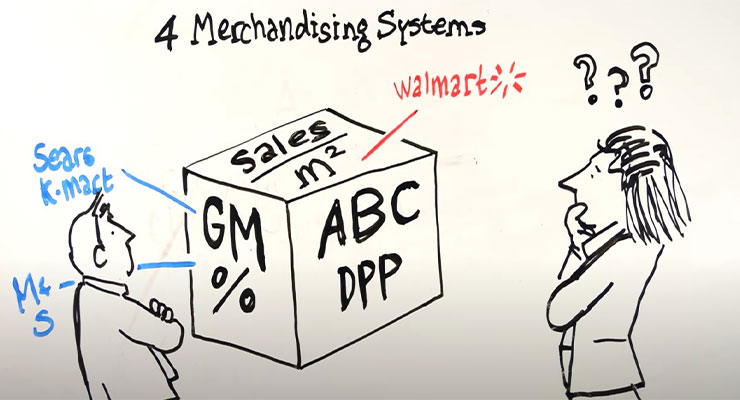By Ansgar John Brenninkmeijer, CEO AJB@ValueMachinesFund.nl
contact and feedback: +31629547689″
This seemingly simple difference in accounting can have significant consequences, as Dieter Brandes, CEO of Aldi Nord & Trader Joe’s, points out: “Many a company has calculated itself out of the market with incorrect equations and inappropriate cost accounting.”
This mathematical disparity may explain why giants like Marks & Spencer and Walmart struggled in Germany.
A simple example illustrates this:
Consider this scenario: you sell two similar products. One is high-quality, priced at €4 with a cost of €2. The other costs you €1. The question is: at what price should you sell the cheaper product to match the profitability of the high-quality one?
| Factory gets | Customer pays | |
| High-quality | €2 | €4 |
| Other product | €1 | €? |
You sell the same quantity: the same number of units of both. At what price would the cheaper product contribute the same profit to the store as the high-quality product?
If you ask a room of retailers, they will disagree. Some will answer “€2” some will say “€3” (a few might have another answer).
The founder of Trader Joe’s supermarket recently provided a hint: “We considered how many dollars we made on each sale. Thus, I was willing to make only 13 percent on a $20 bottle of champagne at the time because that was a $2.60 profit. For a $2.00 item, however, I wanted to make a much greater percentage.”
Strangely, at clothing retailer C&A, for many decades the answer was €3, but after C&A Germany merged with C&A UK the “answer” became €2…
A C&A Brenninkmeijer trick: Deckungsbeitrag & Opportunity Costs
C&A, once a dominant player in the European retail landscape, had abandoned the logical German framework in favor of the more common practice of comparing gross margin percentages. However, the traditional German method, centered around the concept of Deckungsbeitrag (Contribution Margin Dollars or Gross Profit Dollars) and Opportunitätskosten (Opportunity Costs), offers a simple yet powerful alternative in a 3-step framework:
- Selling Price − Buying Price Per Unit = Deckungsbeitrag Per Unit (db)
- Deckungsbeitrag Per Unit x Units Sold = Stock Keeping Unit’s Deckungsbeitrag (DB)
- Deckungsbeitrag From All SKU’s − Firm’s Operating Expenses = Total Firm Profit
The key to the German approach is that the actual selling price and gross margin percentage are secondary. What truly matters is the Deckungsbeitrag, the profit generated per unit after subtracting the cost of goods sold. This cost, paid to the manufacturer, is not considered income for the retailer but merely a pass-through. This is particularly evident in the supermarket sector, where, as Dieter Brandes explains, Aldi doesn’t “buy stock” in the traditional sense. Customers often pay for goods before Aldi even pays its suppliers.
Here’s how to determine the selling price for the cheaper product to match the profitability of the high-quality product:
1. Calculate the profit per unit for the high-quality product:
Selling Price – Cost Price = Deckungsbeitrag (db)
€4 – €2 = €2 Deckungsbeitrag (gross profit per unit)
2. Determine the selling price for the cheaper product to achieve the same profit:
Cost Price + Desired Profit = Selling Price
€1 + €2 = €3
Therefore, the cheaper product would need to be sold for €3 per unit to be as profitable as the high-quality product.
The concept of relative Deckungsbeitrag further refines the German approach. It measures the profit per unit of a limiting factor, like shelf space. This helps retailers identify which products maximize profit given limited resources. By understanding the opportunity cost of not selling a particular product, retailers can make more informed decisions about their inventory and pricing.
Instead of focusing on gross margin percentages or allocating expenses like rent to products, German retailers prioritize the concept of opportunity cost. This strategic approach optimizes resource allocation, as evidenced by C&A’s success before it moved away from this methodology. This German framework is detailed in a video, a white paper (www.profitperx.com), and a recently published booklet titled “Breakthrough: C&A’s Secret Formula Rediscovered.”

C&A’s Secret Formula Rediscovered
C&A was set up in Sneek in 1841 by the brothers Clemens & August Brenninkmeijer, but the real breakthrough that led to almost a century of success took place in Amsterdam 65 years later. In 1906, Clemens’s son, Bernard Joseph, discovered a surefire way to snowball net profits. The underlying Opportunity Cost and Contribution dollars system was kept so secret that it was eventually forgotten. Today, C&A has mostly returned to the less profitable pre-1906 system of planning, pricing, and evaluating its assortment. This booklet reintroduces the surprisingly simple math behind Joseph Brenninkmeijer’s retail method.
Successful retail founders around the world, such as Mrs. B (NFM), Ingvar Kamprad (IKEA), Joe Coulombe (Trader Joe’s), Karel van Eerd (Jumbo), and Jeff Bezos (Amazon) have discussed and written about the drawbacks of conventional gross margin percentage frameworks when managing their assortments, pricing and markdowns, but didn’t know the German Opportunity Cost (manufacturing) model could be used as an alternative. This might be the first explanation of how the alternative money-counting framework works how it was developed over generations at C&A, and how it could be implemented again in your company today.







